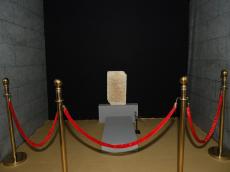|
|
TODAY.AZ / Arts & Entertainment
Karabakh khanate ruler's tombstone restored
21 June 2022 [17:32] - TODAY.AZ

By Azernews
By Laman Ismayilova
The National History Museum has enriched its collection with a unique exhibit.
The tombstone of the founder and first ruler of the Karabakh khanate, founder of Shusha city Panah Ali Khan Javanshir (1693-1763), is on display in the museum, Azernews reports, citing the Azerbaijan National Academy of Sciences.
Director-General of the Azerbaijani National History Museum, academician Naila Valikhanli, Vice-Presidents of the Azerbaijan National Academy of Sciences (ANAS), academicians Isa Habibbayli and Govkhar Bakhshaliyeva, Executive Director of the History Museum, associate professor Farhad Jabbarov, senior members of the Presidium of the Azerbaijan National Academy of Sciences (ANAS) took part in the presentation.
In her speech, Naila Velikhanly pointed out that the National History Museum has been systematically collecting, researching, and promoting a rich collection related to Karabakh history and culture.
She added that the exposition hall also displays a series of unique exhibits related to the history of Karabakh and the city of Shusha, including a 14th-century silver coin with an inscription about minting in Karabakh, two silver keys from the gates of the Shusha fortress, a mace - a symbol of the power of Ibrahimkhalil Khan (1763 -1806 years), rare documents, photographs, drawings, musical instruments, etc.
Academician Isa Habibbeyli stressed that this exposition is of great importance from the social, political and historical points of view.
He underlined that the History Museum provides insight into Azerbaijani history and culture through valuable exhibits and a number of events.
Academician Govkhar Bakhshaliyeva expressed her confidence that the museum exhibits related to the history of Karabakh and the city of Shusha, will become an important source for further research and studies.
Head of the Department of Scientific Exposition and Organization of Exhibitions, Ph.D. in history, associate professor, and curator of the exhibition Sabuhi Ahmadov noted that Panah Ali Khan Javanshir was buried at the Imarat cemetery in Aghdam, where a tomb was built over his grave.
During the Armenian occupation of Karabakh, most of the buildings there were destroyed, including monuments associated with Azerbaijan's prominent figures.
In 1974, the tombstone of Panah Ali Khan Javanshir was brought to the History Museum where it was restored using modern methods.
The museum's restoration laboratory restored the tombstone without damaging its original appearance.
On the first floor, the museum showcases a model of the "Imarat" cemetery and the translation of the inscription on the tombstone, information plates about the history of the tomb as well as Panah Ali Khan Javanshir's portrait by artist Ajdar Gafarov.
The National History Museum also plans to hold a special exhibition and catalog dedicated to the city of Shusha.
The opening of the exposition and the catalog presentation are scheduled for November this year.
URL: http://www.today.az/news/entertainment/221969.html
 Print version
Print version
Connect with us. Get latest news and updates.
See Also
- 31 October 2025 [14:17]
Art Weekend presents exhibition 'In Dew. The Morning That Never Was' - 31 October 2025 [10:00]
National Art Museum presents exhibition dedicated to Tofig Javadov - 31 October 2025 [01:28]
Exhibition titled 'Ancestors' opens in Baku within Art Weekend - 30 October 2025 [15:48]
Ramina Saadatkhan's solo exhibition opens at Nine Senses Art Center - 30 October 2025 [11:36]
Art cruise to be held in Baku within Art Weekend - 30 October 2025 [11:02]
Leyla Aliyeva attends presentation of 'Hirkan' documentary - 30 October 2025 [10:32]
Leyla Aliyeva meets with participant of 'Young Beekeeper' project in Gabala - 29 October 2025 [18:39]
Baku to host VictoryFest-5 Creative Festival - 29 October 2025 [13:18]
BIAF-2025 set to showcase wide-ranging program - 29 October 2025 [12:37]
Masterclass by People's Artist Zahra Guliyeva held in Barda
Most Popular
 Azerbaijani Foreign Minister meets Omani counterpart to boost bilateral cooperation
Azerbaijani Foreign Minister meets Omani counterpart to boost bilateral cooperation
 Azerbaijan, Oman discuss deepening partnership during official talks
Azerbaijan, Oman discuss deepening partnership during official talks
 BIG to host first international conference on Belgian colonialism
BIG to host first international conference on Belgian colonialism
 Azeri Light price declines
Azeri Light price declines
 Azerbaijan strengthens green financing framework for renewable energy projects, says official
Azerbaijan strengthens green financing framework for renewable energy projects, says official
 Locations for new energy storage systems revealed in Azerbaijan
Locations for new energy storage systems revealed in Azerbaijan
 BIAF-2025 set to showcase wide-ranging program
BIAF-2025 set to showcase wide-ranging program
